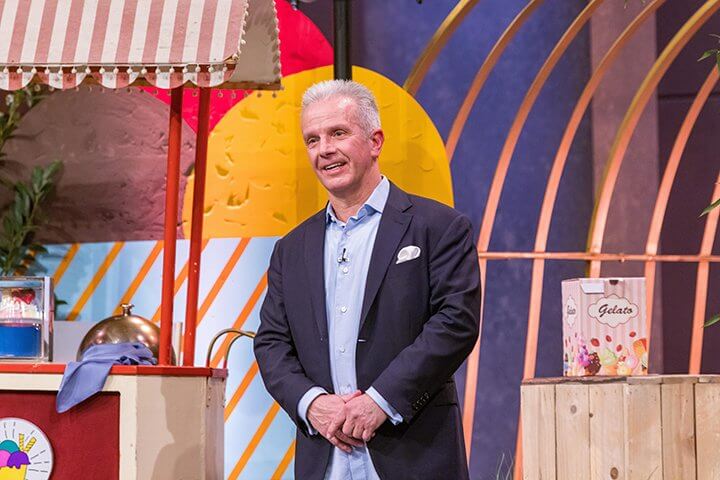Gelato Pack: the importance of early numbers #DHDL
It is by no means only in "Die Höhle der Löwen", but also outside of it, that the vast majority of start-ups find it difficult to get a major investment before they enter the market. Andreas, founder of the innovative ice cream packaging Gelato Pack, also had to learn that investors want figures, even if they are still so early. But is it really just about turnover or something completely different?
Friday,
03.05.2024

Andreas Siebrecht received a lot of praise from the lions because his cool pack for ice cream sundaes was convincing. The lower part of the pack keeps the ice cream creamy and ready to eat, while the upper part is perfect for whipped cream and decoration. The lions not only liked the flavour of the ice cream it contained, they were also immediately impressed by the packaging.
The questions therefore quickly turned to the business model, and the lions had no doubt from the outset that this had to be a B2B model, meaning that the customers would be companies and not end consumers. The founder confirmed this and named delivery services in particular, which could also deliver whole ice cream sundaes to customers’ homes in summer, retailers, who could include ice cream sundaes with the Gelato Pack in their chiller cabinets, and ice cream parlours as his customers. The latter could perhaps expand their customer base, as the sundae stays fresh and cold for over an hour in the Gelato Pack, even at 40 degrees.
However, it quickly became clear that they were dealing with a start-up in which the use case and business model are closely interwoven and must first be clearly defined.
This is because Nils Glagau and Carsten Maschmeyer play through the case of the delivered ice cream cup and don’t just ask about the costs. With an extra €1.10 for the packaging, of which 61 cents are production costs, there is a margin for the young start-up, but there are considerable extra costs for customers and/or the ice cream parlour making the delivery, as delivery costs are of course not included here.
However, the two lions immediately realise that this €1.10 cannot include the cool packs that are part of the gelato pack and want to know how this problem can be solved. The answer is that the cool packs have to be returned, ideally the supplier will take them back immediately. However, this also means that the ice-cream tub must be unpacked immediately and the cool packs removed. If the customer is unable or unwilling to do this, they must pay a pre-defined deposit, which increases their willingness to return them later.
But this is already the first point at which investors ask themselves whether the use case for such a model is correctly defined. Is a customer even prepared to pay another €1.10 for a sundae that might cost €10 and then another €1.10 for the delivery costs? Or does the ice cream parlour have so much margin that it would want to subsidise the delivery in full or in part?
And if one of these were to apply, would the customer actually use it, or would it be too much effort for him or her to immediately unpack the ice cream cup to return the cool packs? Or would the deposit system be acceptable instead? These are all questions whose answers determine whether such an invention – which is actually a great and practical one – will really be a commercial success. Because, to put it bluntly: even if Gelato Pack finally makes it possible to have a cup of ice cream delivered, who is to say that it is worth the extra money for people to actually do it?
This is precisely the crux of why even the early figures are so important to investors. After all, even the smallest figures, which have emerged from real business, can already contain the initial information that gives a business model more shape and therefore less risk.
Carsten Maschmeyer is quick to ask why not much has happened here yet. Founder Andreas responds with the long development time and that he has already spoken to ice cream parlours. However, he also admits that he has also received feedback that some ice cream parlours are so busy in the summer that it would be an unnecessary extra effort for them to pack orders as well.
Afterwards, you can really tell that the lions don’t really believe that the model could work. Even though Andreas unpacks all his sales skills and receives a lot of praise from the lions, he can’t turn the tide.
Carsten Maschmeyer sums it up by saying that although he recognises that he is a strong salesman, his figures are unfortunately very weak – because he doesn’t have any.
But especially when there are doubts about the use case, doubts about whether and who would really pay for something, or whether customers would really want to use it in this way, the very first figures can be an immense help in dispelling such doubts.
In the Gelato Pack example, something along the lines of “We’ve spoken to around 20 ice cream parlours and 15 would use it and pay the proposed price” or even a survey along the lines of “We asked 200 customers and over 100 would like a better way of making ice cream sundaes available as takeaways” would be a step forward. Although you have to be careful with such surveys, because it is well known that many people answer the question “Would you use/buy something like this?” with a yes out of sheer politeness, anything that confirms the use case and, ideally, customer interest is worth a lot. And nothing confirms this as much as actual sales. Precisely because politeness can then no longer be involved, but real willingness to pay.
In order to be able to really utilise your talent as a salesperson, you first need to be clear about which type of customer is actually the most promising, and what they would actually use the product for and in which situation. Otherwise, even the greatest sales force will largely come to nothing.
It is therefore to be hoped that the dedicated founder of Gelato Pack will soon be able to make up for this initial validation. And soon convince the first customers, even if it didn’t work out with the lions.
Photo (above): TVNOW / Bernd-Michael Maurer

Ruth Cremer
Ruth Cremer is a mathematician and consultant as well as a university lecturer in the field of business models, key figures and financial planning. As a former investment manager, she knows what investors look for and also helps with pitch and document preparation in the investment or acquisition process. Since 2017, she is involved as an external consultant in the selection and preparation of the candidates in "Die Höhle der Löwen".
